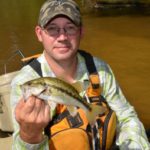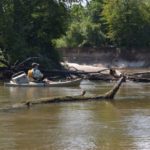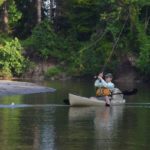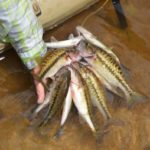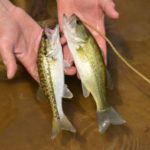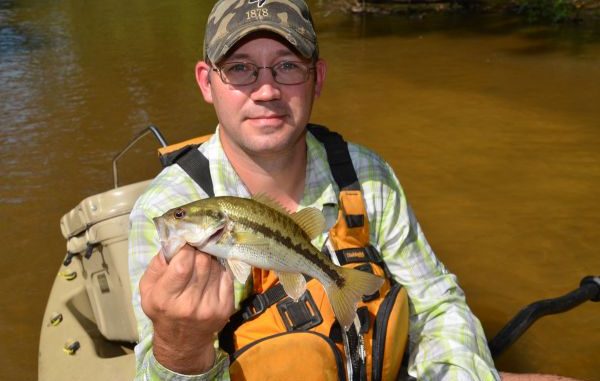
Tucked into the wilderness of Southwest Louisiana is a small stream that offers beautiful paddling opportunities — and it’s packed with aggressive redeye bass, aka spotted bass. Here are some tips on how to catch them.
The sign set off the road read, “Welcome to Oberlin, Gateway to Canoe Country.”
Canoes and tumbling creeks and rivers of clear water are the last things many Louisianans would think of as being part of their state.
Yet, here it was.
The people who live here know it and love it, but most of the rest of the state’s residents unknowingly bypass it. Set north of Interstate Highway 10, south of the approaches to Toledo Bend Reservoir and west of the heavily populated Cajun Triangle and Interstate Highway 49, you don’t pass through it going anywhere.
You have to be going there to go there.
And it’s worth going to this land, cloaked with green forests and rent with creeks and rivers so clear they look more like rainbow trout waters than bass waters.
But bass was why I was here. I was burning with anticipation.
The Ouiska Chitto River was legendary, at least to me. I was weaned on the Louisiana Department of Wildlife and Fisheries’ Louisiana Conservationist magazine, what I considered the best hunting and fishing magazine in the world.
In the 1950s, someone on the staff loved floating the Ouiska Chitto — usually called the Whiskey Chitto — and wrote about it often.
I still remember the black-and-white images that accompanied the articles, showing khaki-clad, middle-aged guys floating on heavy, clunky bateaus and casting knuckle-buster (no free-spool in those days) casting reels.
After 87 years of publication, the magazine is gone, dying an ignominious death in 2010, supposedly to be replaced (since everybody knows that no one reads paper magazines anymore) by an online magazine.
The online version has since been published sporadically, and the content that once appealed to hunters and fishermen (who along with commercial fishermen, pay the freight for LDWF with their license purchases) has completely changed.
In the issue current at the time this piece was written, the three feature stories were on a program for students on spawning paddlefish, a state tournament for the agency’s archery in the schools program, and an educational symposium for teachers and students with an environmental specialist.
Red meat for dedicated hunters and fishermen.
So the magazine is history, but the river and its fish are still here.
I had been waiting over 55 years. That’s a long time.
Friend and kayak mentor John Williams, who owns of Pack & Paddle in Lafayette, found out about my yen to fish the river and hooked me up with Jesh Smith, a degreed forester from DeRidder who now works as a rental property manager.
I met Smith near the teeny-tiny little town of Mittie.
At first glance, the river’s waters appeared disappointingly milky. It had rained 1 1/2 inches late in the preceding afternoon, but Smith decreed the river to be fishable, although less than ideal, and we launched our kayaks.
The rain was local, he said. If it had been farther up in the river’s drainage, the river would have turned churning and muddy.
My lessons on reading water began immediately.
Least productive of fish is what he called “flat water” — straight stretches of water that show little current and have little structure to break the current. These he generally ignored, seldom casting into them.
The best fish-holding areas were cut banks, where a meander in the river threw the full force of its current against a vertical bank, undercutting it, and washouts under and around tree stumps and logs.
As Smith floated, he kept one leg dangling over the side of the kayak at all times. He used the leg on logs, stumps and in shallow water on the bottom to stabilize the kayak.
Smith brought both spinning and fly-fishing tackle, but he planned to spend most of the day with his fly rod.
His style was interesting and well-adapted to creek fishing. He left 15 to 20 feet of fly line out at all times, and simply flipped it from spot to spot in front of the kayak as it moved.
“By keeping the same length of line out I don’t have to deal with the reel at all,” Smith explained. “The art in this is in boat control, but it has the disadvantage of always having to paddle one-handed.”
That explained why he kept one foot overboard.
Another action unique to Smith’s style occurred when a fish struck his popper.
He didn’t strip the line in, like most fly fishermen do. Rather he reeled every fish in.
“Reeling instead of stripping helps me avoid line tangles,” he explained.
It felt like we were floating through a wilderness, with galleried hardwood forests on both sides of the river. While “babbling” might be too poetic a word to describe the sound of swift-flowing water moving over sandbars and around logs, it was definitely musical.
Doubtless, Smith enjoyed the scenery, but he seemed to be lost in concentration in very quietly controlling the position of his kayak and presenting his popper. He didn’t finesse the lure at all, rather letting the current move it.
It worked.
Redeye after redeye darted to the surface to smash the little lure.
Mixed in for variety was the occasional brilliantly colored and spunky longear sunfish, usually called “sun perch” by creek fishermen.
“Spotted bass are aggressive,” he explained about his efforts to be quiet, “but the more stealthy you are, the better. I see people come banging down the creek and making noise.”
Any fish Smith decided to keep was strung up on a rope stringer tied to his kayak and left to trail in the water. He carried a small ice chest on the stern of his kayak, but it was reserved for drinks and lunch items.
Although he often catches spotted bass weighing several pounds, he doesn’t mind stringing up little guys.
“People laugh at me for keeping little bass,” Smith grinned, “until they eat at my house. They are sweet-tasting.
“I prefer them over largemouth bass any day.”
As Smith’s kayak floated quietly down the scenic little river, he piloted it from one side to the other as the main force of its current flopped with the many bends in its bed.
“You don’t catch many fish on the shallow sandbar side of the river,” he explained, “and you don’t want to fish in the strongest current, either.”
He was always glancing ahead, even drifting backward while unhooking a fish. It’s critical, he said, not to get the boat lodged sideways against a stump in the current.
He ruefully admitted to learning the lesson by being flipped often.
Even without the willing fish, the scenery was worth the float: glistening white sand beaches; the green jungle flanking the river; the clear, slightly tannic river water; even the big black buzzards circling lazily in the blue sky overhead.
The trees along the river were festooned with muscadines and possum grapes. It took a lot of will power not to stop every couple hundred yards to pick from the heavily laden vines.
Smith swapped his fly rod for a spinning rod after a couple of hours, noting that he has seen times when all the fish wanted to eat was flies. But he said that he has also seen it where he picks up a fish here or there on flies, and then tries a soft plastic and “smokes them.”
One advantage to a spinning rod, he went on, is that it allows the fisherman to flip a lure into places where it is hard to put a fly.
He uses mostly soft plastics, but doesn’t bottom-fish the lure at all, rather swimming it back to the kayak.
“Bait placement with spinning tackle is critical,” Smith said. “A foot short of an overhanging bank and the fish won’t come out to get it. A foot too far and the bait is hung up.”
It took split-second timing for him to lob a cast, make the retrieve and grab a paddle to avoid a wreck.
Smith easily reached his limit, but practiced catch and release the rest of the float to his take-out point.
The bite never slackened.
“One nice thing about creek bass,” Smith said, “is that time of day doesn’t matter to them.”
